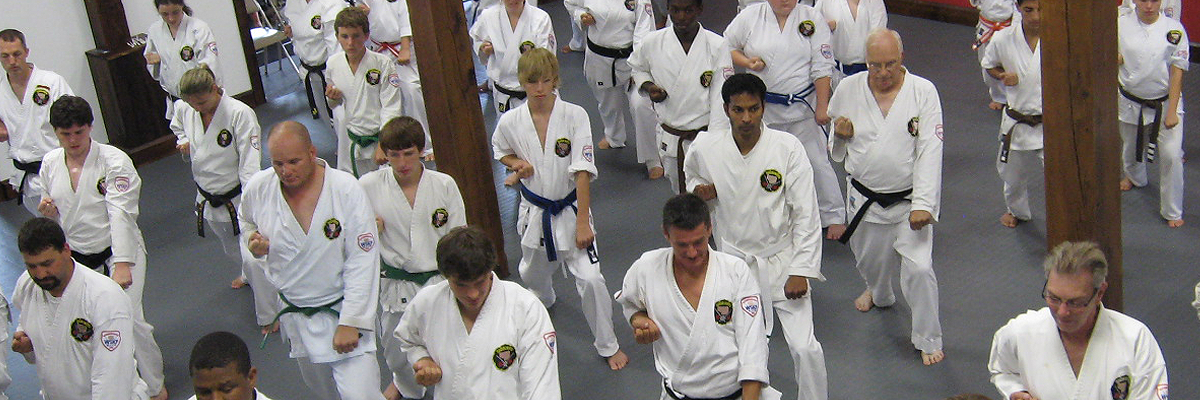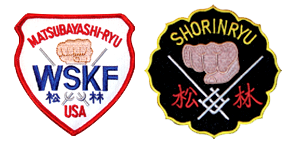Kata of the World Shorin-Ryu Karate-Do Federation

“Kata does not teach you how to fight, it teaches you how to move.”
Hanshi Frank Grant
Grand Master Nagamine chose eighteen kata for Matsubayashi Shorin-Ryu. Today these kata continue to be taught to WSKF students by Hanshi Grant's Senior members in the same way he was instructed by the Grand Master. Kata is executed one way. A white belt’s technique when executing Fukyugata Ichi will be different than a green belt or a black belt. Over time as you progress in your training, you begin to adopt the techniques to your abilities. Hanshi Grant said, “Kata does not teach you how to fight, it teaches you how to move.” Here is a brief description of the eighteen kata of Matsubayashi Shorin-Ryu.

Fukyugata Ichi
Grand Master Nagamine developed this kata at the request of an Okinawan government official in 1940. It was designed to be the first and most basic kata for students of all styles to practice. Grand Master Nagamine practiced this kata daily.

Fukyugata Ni
Chojun Miyagi, Grand Master of the Goju-Ryu style, developed this kata. Fukyugata Ni offers the first exposure to the mae geri (front kick) and the use of the empi (elbow).

Pinan's
Shodan, Nidan, Sandan, Yondan, Godan
The Pinan kata were developed by Anko Itosu in 1907 from older kata, including Kusanku, into easier forms for teaching karate to young students. Pinan translates to “peaceful and calm.”

Naihanchi's
Shodan, Nidan, Sandan
The composer of the Naihanchi kata is unknown. Before the Fukyugata and Pinan kata were developed, karate students would oftentimes learn Naihanchi Shodan as their first kata. These kata are mainly used for the development of the lower body.

Ananku
The composer of this kata is unknown. At first glance, Ananku appears to be a simple kata, but it is deceiving. Ananku is a power kata.

Wankan
The composer of this kata is unknown, but it has a long history. The characteristics of this kata are its elegance combined with powerful movements of offensive and defensive sequences.

Rohai
The composer of this kata is also unknown. Rohai is a very beautiful, flowing kata that is often referred to as the “blind man’s kata” or a night-fighting kata. With the correct cadence, Rohai not only demonstrates very effective and powerful karate technique, but also teaches a fighting philosophy as to when you should execute slowly and when you should explode.

Wanshu
Like other advanced kata, Wanshu was redeveloped by karate men after the kata was brought to Okinawa. Wanshu is the only kata in Matsubayashi Shorin-Ryu with a dynamic hidden punch.

Passai
The composer of this kata is unknown, but you can see some Chinese influence in the techniques with many circular motions using open hands. This is an extremely beautiful kata with flowing motions.

Gojushiho
Although the origin of this kata is unknown, Chinese influence can been seen in many of the moves in Gojushiho. Jabbing techniques with the fingers and side movements done in what could be described as a “drunken manner” are unique to this kata. Gojushiho literally means 54 moves.

Chinto
Again, the origin of this kata is unknown. Chinto is performed on a single line that is at a 45 degree angle from the starting point. You are fighting attackers on either side of you. Chinto is the only kata in Matsubayashi Shorin-Ryu with a double jump kick.

Kusanku
Kusanku was named after the Chinese karate man, Kusanku. This kata is distinguished by having the most advanced techniques and is the longest and most difficult kata in Matsubayashi Shorin-Ryu. Many of the sequential movements in Kusanku can be found within the Pinan kata.
Ganbaru-Sho
In addition to the 18 Matsubayashi-Ryu kata, Hanshi Grant left us with his personal signature kata, Ganbaru-Sho. Ganbaru-Sho is more than just a word in Japanese and Okinawan culture. It is a concept. Often translated as "doing one's best", in practice, Ganbaru means doing more than one's best. One on hand, with continuous effort and hard work, one can rise victorious despite obstacles and personal limitations. On the other hand, success is never assured. The goal may be unattainable, but it's important that we give every ounce of our being, never giving up on our journey and exceeding expectations because it is worth it.
